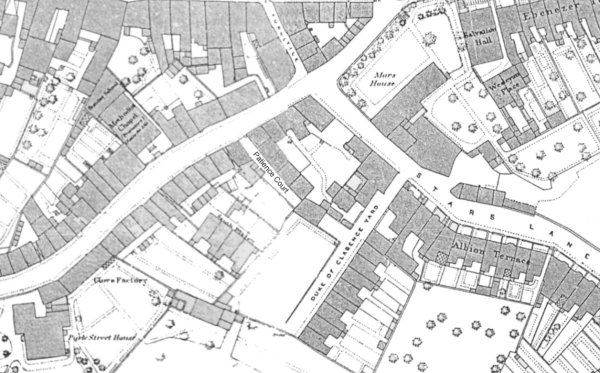pashen's court
pashen's court
Slum housing off South Street
Pashen’s Court,
later corrupted
to Patience
Court, was a
‘court’ of five
dwellings off
South Street and
at right angles
to it, just a
couple of
buildings away
from the
junction with
Stars Lane. It
was named after
George Pashen
who was a linen
draper of
Kingston, a
preacher and one
of the original
trustees of the
Tabernacle
Chapel. He is
listed in
Pigot's trade
directories of
1824 and 1830,
possibly
indicating that
the court became
known after him
from about this
time. He was
also a member of
the
Vestry.

George Pashen's
signature
against the
Vestry minutes
of 3 March
1831.
The 1851 census
listed five
families living
in Pashen’s
Court, a total
of 24 people
comprising six
men, twelve
women and girls
and six
children. Of the
men two were
glovers, two
farm labourers,
one was a stone
sawyer and the
last was a
blacksmith. All
twelve of the
women and girls
were listed as
glovers or glove
sewers, the
youngest being
aged 11. These
would have been
glove factory
'outworkers'
sewing and
finishing gloves
in their own
homes.
In December
1851, following
a cholera
epidemic in
1848-49, the
Board of Health
held a public
enquiry headed
by Dr Thomas
Rammell, the
Board’s
inspector, into
the public
health and
sanitary
conditions of
Yeovil town. Dr
Tomkins, in
giving evidence
at the enquiry,
cited Pashen’s
Court as an
example of poor
hygiene where
all the houses
in the court
shared one privy
that was so
close to the
court’s well
that it became
contaminated.
In 1896, as part
of a ‘town
improvement’ the
Town Council
closed Pashen’s
Court. The site
was developed as
the
Palace
Theatre and, in
turn, the later
Gaumont cinema.
map

1886
Ordnance Survey
showing Pashen's
Court as
Patience Court
at centre.